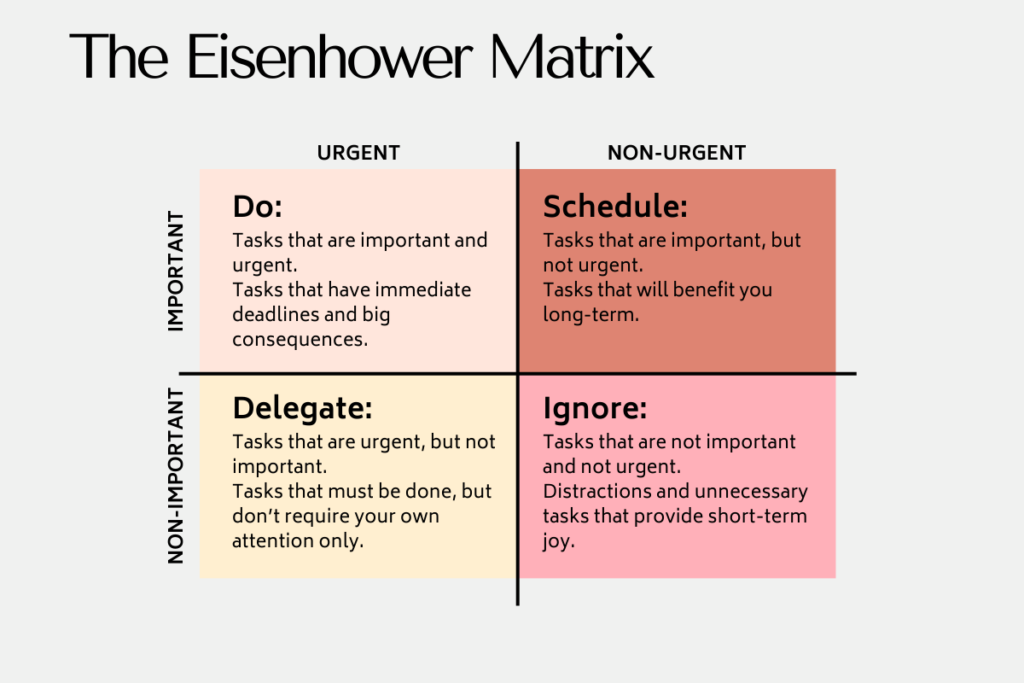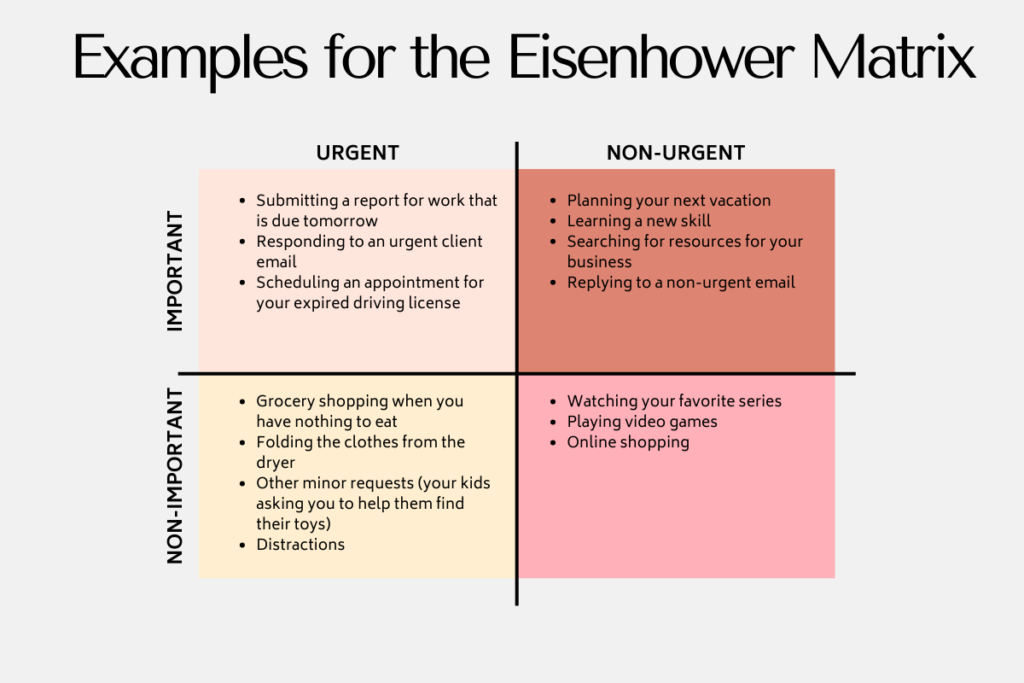When I was a high school student I enrolled in a lot of extracurricular activities and academics and I quickly found myself drowning in tasks, constantly feeling overwhelmed and stressed by my long to-do list. At this time, one of my teachers told us about the Eisenhower Matrix, a simple yet powerful tool that transformed my time management for the better and helped me identify tasks that were very important for my personal growth.
I was very intrigued at the beginning by the concept of categorizing tasks based on urgency and importance. However, I tried to embrace this concept and it literally changed my life for the better. I identified the tasks that were urgent and important, and worked on them, letting aside those tasks that were time-consuming, not important, and not urgent. This behavior allowed me to build self-discipline and devote more time and energy to the important tasks that would move me closer to my goals.
Let’s discover what is the Eisenhower Matrix and its transformative power.
What is the Eisenhower Matrix?
The Eisenhower Matrix, named after the 34th President of the United States, Dwight D. Eisenhower, is a time and task management tool that helps you prioritize tasks based on urgency and importance. Classifying your tasks into four quadrants allows you to gain clarity, focus on what matters most, and minimize distractions that hinder your progress.
Moreover, using the Eisenhower Matrix, also known as the Urgent-Important Matrix, will help you combat burnout in the long term, allowing you to focus on the tasks that are the most important for you and your personal development, without getting distracted from your work.
The Eisenhower Matrix was designed as a simple tool focused on categorizing tasks based on two features:
- Urgent/Non-Urgent Tasks
- Important/Non-Important Tasks
You can use the Eisenhower Matrix across work and personal life and it will allow you to effectively manage stress, prioritize tasks for increased productivity, and achieve your SMART goals with optimal time management.
How to identify Urgent and Important Tasks
Start by listing all the tasks that you need to complete in a certain time frame (focus on the next day, next week, or maybe next month, and don’t go further in time). You need to list all your time-consuming tasks, including work-related tasks, personal tasks, and mundane tasks but try to focus only on those tasks that take more than half an hour to complete. That way you will not get lost in details.
Then assign two labels for each task, one for importance (ask yourself if this task is important or not?) and one for urgency (do you need to complete it immediately or not?).
Urgent tasks will require your immediate attention and have to be done now or within a short time frame from now on. These tasks usually have consequences and you shouldn’t skip completing them. They are unavoidable and the longer you delay doing them, the more stressed and pressured you will feel.
Important tasks support your long-term goals, but they are not necessarily urgent. However, you aspire to complete them because they matter for your overall development. You need a strategy to tackle them over time.
Then you need to place the tasks into the four quadrants of the Eisenhower Matrix and discover how to complete them effectively.
Understand Each Quadrant of the Eisenhower Matrix
Once you have created your list of tasks for a certain time frame, it is time to separate them by quadrant. Once you categorize your tasks, you will be able to incorporate them into your daily life and accomplish them with ease.
Quadrant 1: Do
The first quadrant is reserved for tasks that demand your immediate attention and significantly impact your long-term objectives. These are the tasks that often weigh heavily on your mind, causing stress and anxiety. Identify tasks with clear deadlines, tangible consequences, and a direct link to your goals, and place them in this quadrant for swift and decisive action.
Quadrant 2: Schedule
The second quadrant focuses on tasks essential for your long-term goals, but do not have consequences if you don’t complete them immediately. These tasks contribute significantly to your development, however, you should create a strategy to work on them over an extended period. You can use time management techniques, such as the Pareto Principle to schedule and prioritize these tasks.
Quadrant 3: Delegate
Quadrant 3 is the place where you can place tasks that are not important but need to be completed. They usually don’t have any negative consequences if you don’t complete them immediately. Try to delegate these tasks whenever possible. They usually don’t require a certain skill anyway.
Quadrant 4: Ignore
After placing all your tasks into the above three quadrants, you are left with a handful of tasks. These tasks are the non-important, non-urgent ones and you can safely ignore them for the time being. These are usually distractions, interruptions, or pleasures that don’t contribute to your goals.

Tips for prioritizing your tasks
1. Categorize your tasks into the 4 quadrants
Classify your tasks into the four quadrants of the Eisenhower Matrix: Urgent and Important (Do), Important but Not Urgent (Schedule), Urgent but Not Important (Delegate), and Not Urgent and Not Important (Eliminate). This helps you identify which tasks require immediate attention and which ones can be tackled later. Use the guidelines above.
2. Limit tasks per quadrant
To avoid feeling overwhelmed, limit the number of tasks you place in each quadrant. Aim to have no more than three to five tasks per quadrant. This will help you focus on the most critical tasks and avoid getting bogged down by a long to-do list.
3. Prioritize tasks within each quadrant
Once you’ve categorized your tasks, prioritize them within each quadrant. Try to focus on the highest and second highest-priority task first, then move towards the end of the list in the first quadrant. After completing those tasks, you can tackle the second to fourth quadrants in a similar way.
4. Try separating personal and professional matrices
Considering that the goals, deadlines, and priorities for work and personal life differ, creating separate Eisenhower Matrices can be helpful. This allows you to focus on the specific tasks and objectives of each area of your life without getting them mixed up.
5. Regularly review your Eisenhower Matrix
Your priorities and workload can change frequently, so it’s essential to regularly review and update your Eisenhower Matrix. As tasks are completed or new ones arise, reflect on their urgency and importance and adjust their placement accordingly.
Eisenhower Matrix Examples
Task examples for Quadrant 1:
Urgent and Important Tasks:
- Submitting a report for work that is due tomorrow
- Responding to an urgent client email
- Scheduling an appointment for your expired driving license
Task examples for Quadrant 2:
Important but Not Urgent Tasks:
- Planning your next vacation
- Learning a new skill
- Searching for resources for your business
- Replying to a non-urgent email
Task examples for Quadrant 3:
Urgent but Not Important Tasks:
- Grocery shopping when you have nothing to eat
- Folding the clothes from the dryer
- Other minor requests (your kids asking you to help them find their toys)
- Distractions
Task examples for Quadrant 4:
Not Urgent and Not Important Tasks:
- Watching your favorite series
- Playing video games
- Online shopping

Conclusion:
The Eisenhower Matrix, with its straightforward principles and practical application, provided me with the tools I needed to conquer my time management challenges. It not only helped me reduce stress and improve my productivity but also instilled in me a sense of control over my time and a clearer vision of my goals.
I hope you found my article informative and helpful. Please continue to explore my blog for more valuable content.
Related Articles:
The Only 30-Day Self-Care Challenge You’ll Ever Need
37 Habits That Will Make You a Smarter Person





